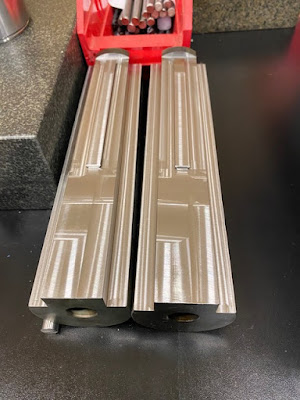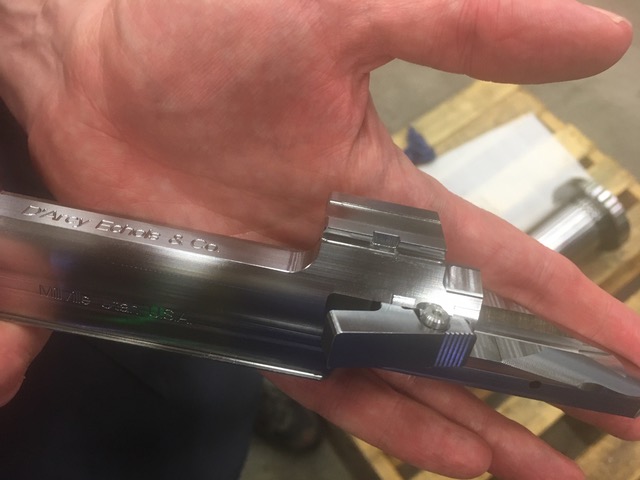Prototype number 1 was completely assembled late one evening and run through the paces as best one can do without a barrel installed. So far, so good.
LX-1 Specifications
If anything, the LX is a return to the earlier basics of bolt action engineering with one pivotal twist and that is the implementation of computer-generated modeling, machining done with modern multiple axis machining centers, implementing modern materials coupled with advanced heat treatment capabilities for those materials chosen.
The idea behind the project was to combine what I considered the best features from a variety of receivers made in the past and blend these together into a singular modern manufactured big game receiver. Then machine the parts with 100% repeatability from one receiver to the next.
Within reason the design did not have meet a specified budget ceiling rather it was more important to maintain the accuracy of all the final parts being the objective and not a price point.
The end goal was to produce a receiver and bolt that did not require blue printing, a receiver that did not require the rebuilding the trigger, safety and fire control system. Having a feeding system that was properly set up to begin with and a scope mount system that was bullet proof right out of the box.
Having spent the last 4 decades re-vamping, modifying and morphing pre-existing receivers into what I considered reliable actions for Big Game hunting I finally had to admit I’d become very tired of repairing and repainting the same old fence.
Points of interest
1. The receiver body is made from 416 Stainless material. These are available in Right- and Left-handed models. The flat bottom of the receiver is like the Winchester Model 70. The sides of the receiver are radial in cross section and then tapered under the stock line to allow ease in bedding and removal from the bedded cavity. The action utilizes 3 guard screws with the front screw mated into a boss that takes full advantage of the thread form in width and length. The barrel threads within the receiver are cut to 1.062 x 16 TPI The bolt face utilizes a cone breech design. There will be no need to blueprint this receiver as it happened at birth.
2. The Bolt Body is made of Chrome-Moly Steel along with 98% of the remaining parts of the receiver group. This change in steel composition allows the C/M bolt to operate or run with noticeably less friction when the bolt is manipulated. The amount of material left on the bolt handle root also blocks the extractor slot behind the ejection port of the bolt raceway as a physical gas block. There will be no need to blueprint this bolt body for the same reasons of design.
3. The bolt stop was designed to be robust. The flange of the stop itself acts as a gas block within the solid side of the bolt raceway. The back side of the stop fits flat against a pocket machined into the receiver that will take the impact of the bolt being manipulated under stress. Pressing the rear of the stop against the receiver pivots the stop away from the receiver allowing you to remove the bolt body with one hand if necessary.
4. The scope bases are integrally machined into the receiver eliminating the need for an externally fit scope base secured by 4 screws alone. These dovetails are machined very low on the receiver and are designed with a .010 down slant angle towards the muzzle.
5. The Trigger is a direct copy of the original Model 70 trigger. The advantage of this design was the brilliance of so few moving parts and is impossible to put out of commission environmentally. The LX version is machined to closer tolerance than the original M-70 trigger could be machined due to manufacturing tolerances and cost constraints at the time.
6. The claw extractor system is arguably hard beat on a big game hunting rifle. The LX features a claw extractor made from appropriate machined steel and fit for the OD groove diameter of the cartridge cases to be used when requested. The length of the extractor places the tail or rear end to the extractor under the rear bridge of the receiver to prevent the extractor from being stripped off the bolt body during manipulation of the bolt under stress.
7. The bolt shroud is machined, timed and fit to prevent the shroud, firing pin and safety as an assembled unit from rising away from the sear pad, thereby effecting the weight of pull of the trigger. The shroud supports a 3-position wing safety. Allowing the rifle to be properly unloaded with the safety still engaged. A flange on the leading edge of the shroud also acts as a directional gas shield at the rear of the bolt notch raceway.
8. The Floorplate and Trigger Bow assembly are made in a 3-piece design with a release latch lever located inside in the bow. The Magazine boxes and followers are made cartridge specific; One Size does not fit all with the LX-1. The magazine boxes are made from heat treated steel and will not distort over time when used with heavy recoiling rounds. Currently there are 3 separate magazine boxes available. Group # 1 is designed for the 25-06 up through the 35 Whelen, the 2nd group is designed for the standard belted magnums, such as 264 Winchester, 7mm Remington, 300 Winchester, 416 Remington up to the 458 Lott. The 3rd magazine box is designed for the 300 H&H and 375 H&H Magnum.
9. The scope rings are made from heat treated 4130 Chrome-Moly steel. Currently they are available in 1”, 30mm and 34mm ID diameters and in a selection of heights to keep the scope as low in height that is reasonably possible. They will allow most 50 mm objectives too clear a sporter weight contour barrel. The limiting factor is the mounting length of the straight tube section on any given scope. These rings can be detached in 30 seconds to allow a variety of scopes to be used, a backup scope to be quickly installed to replace a damaged primary scope. A recoil stop is machined integrally into the clamp jaw of each ring and prevents any forward or rearward movement of the scope during recoil.
10. In an effort to reduce weight for those that feel physically challenged the following parts will be available in 7075 Aluminum. The follower, 1” and 30mm scope rings as well as the Floor Plate and Trigger Bow Assemblies can also be made of 7075. This option only applies to Legends and not Classics. Everything else will be made of Carbon or Stainless steel.























































